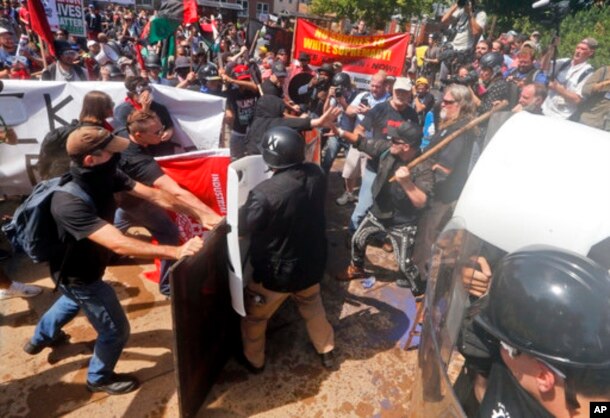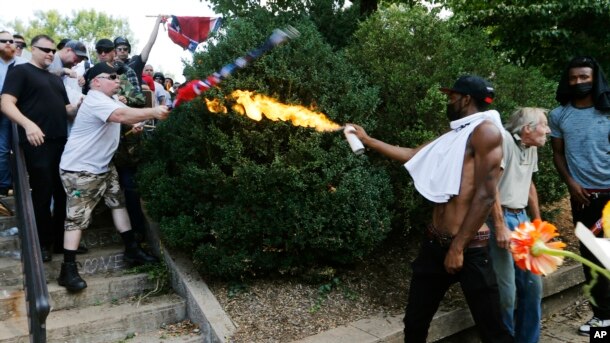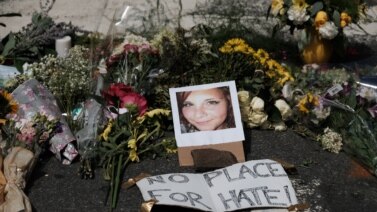
Signs for the recent protest in Charlottesville, Virginia promised to “Unite the Right.” That expression was directed at white nationalist groups that oppose the removal of a statue from a public park in the city.
The statue is of General Robert E. Lee, who led Confederate forces in battle during the Civil War. After four years of fighting, Union forces defeated the Confederates.
The white nationalist groups have different plans and goals. Here is a look at some of the terms used to describe some of those present at the protest.
White supremacist
White supremacists believe the white race is better than other races. The Southern Poverty Law Center (SPLC) is a nonprofit civil rights group. It says white supremacy is a historically-based system of abuse and oppression of continents, nations and peoples of color by white people and nations of the European continent. The SPLC says the aim of the system is to protect and defend a system of wealth, power and rights.
Alt-right
Some white nationalists and white supremacists use the term “alt-right” to describe themselves. They want to restrict immigration, limit government powers, and enforce law and order. They believe Western culture is better than other cultures. Alt-right activists do not agree with the democratic ideal that all members of society should have equal rights.

KKK or the Knights Party
The Ku Klux Klan (KKK) is one of the oldest hate groups in the United States. The group has a long history of violence. It began targeting black Americans. But it has also attacked Jews, immigrants, homosexuals and, until recently, Catholics.
In 1975, David Duke founded the Knights of the Ku Klux Klan. Duke said his goal was to make the KKK less violent. He and his supporters call themselves the Knights Party. They believe that non-whites should obey Christian teachings. They believe whites must not marry or live near non-whites. They also believe that “in the years to come,” they will be recognized by the American people as the white rights movement.
Neo-Nazis or American Nazi Party
The Neo-Nazis or American Nazi Party wants all Aryans in North America to unite. On its website, the party says there must be “an all-White National Socialist America; an America in which our children and our grandchildren will play and go to school with other white children; an America in which they will date and marry other young people of our own race; an America in which all their offspring will be beautiful, healthy white babies.” The party says the culture, society, businesses and politics of the United States should be free of foreign and Jewish influence; “an America in which White people are the sole masters of our own destiny.”
Neo-Confederate
Neo-Confederates believe the American Civil War never ended. They consider themselves members of a new Confederate Army. Their goal is to have a country made up only of the southern states.
Traditional Workers Party
Members of The Traditionalist Worker Party believe the U.S. is “far too large, diverse, and infested with lobbyists and oligarchs for realistic solutions to come from a centralized, top-down approach to solving political problems.” The group wants power taken from “the corrupt and unaccountable federal government.” It says power should be given to “community and regional leaders who stand for traditional values, strong families, and revived cultures.”

Groups opposing the “Unite the Right” demonstration
At least two opposing groups publicly opposed the protest last Saturday.
Black Lives Matter
The Black Lives Matter (BLM) group says on its website that it is working for the “validity of black life.” The group was founded in 2012 after the shooting death of Trayvon Martin, an African-American teenager. BLM says it supports “black queer and trans folks, disabled folks, black-undocumented folks, folks with (criminal) records, women and all black lives along the gender spectrum.”
Antifa
Antifa is short for the term anti-fascists. Mark Bray wrote a book called Antifa: The Anti-Fascist Handbook. He says the antifa movement came out of resistance to Italian leader Benito Mussolini and German leader Adolf Hitler in the 1920s and 1930s.
The movement opposes the alt-right and the rule of U.S. President Donald Trump. These groups are not organized and not considered widespread throughout the country. They strongly oppose discrimination against homosexuality, racism, sexism, and sometimes capitalism.
VOA’s Aline Barros researched and wrote this explanation of protest groups in the United States. Christopher Jones-Cruise adapted her report for Learning English. George Grow was the editor.
We want to hear from you. Write to us in the Comments Section, or visit our Facebook page.
Words in This Story
homosexual - n. a person who is sexually attracted to people of the same sex
Aryan - n. used in Nazism to identify a supposed master race of non-Jewish whites with Nordic features
destiny - n. what happens in the future; the things that someone or something will experience in the future
infest - v. to fill (a place) in large numbers
lobby - n. an organized group of people who work together to influence government decisions that relate to a particular industry, issue, etc.
oligarch - n. a person who belongs to a small group of people who govern or control a country, business, etc.
validity - n. the state of being acceptable according to the law
queer - adj. homosexual (offensive in most of its uses, but it is also now sometimes used in a neutral or positive way especially by some homosexual and bisexual people.)
trans - adj. abbreviation for transgender (which is defined as “of or relating to people who feel that their true nature does not match their sex at birth”)
spectrum - n. a complete range of different opinions, people, etc.
